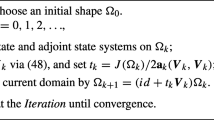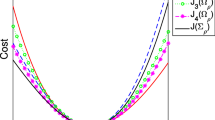Abstract
The Bernoulli problem is rephrased into a shape optimization problem. In particular, the cost function, which turns out to be a constitutive law gap functional, is borrowed from inverse problem formulations. The shape derivative of the cost functional is explicitly determined. The gradient information is combined with the level set method in a steepest descent algorithm to solve the shape optimization problem. The efficiency of this approach is illustrated by numerical results for both interior and exterior Bernoulli problems.








Similar content being viewed by others
References
Lacey AA, Shillor M (1987) Electrochemical and electro-discharge machining with a threshold current. IMA J Appl Math 39:131–142
Friedman F (1984) Free boundary problem in fluid dynamics, Astérisque. Soc Math France 118:55–67
Acker A (1977) Heat flow inequalities with applications to heat flow optimization problems. SIAM J Math Anal 8:604–618
Acker A (1981) An extremal problem involving distributed resistance. SIAM J Math Anal 12:169–172
Fasano A (1992) Some free boundary problems with industrial applications. In: Delfour M (ed) Shape optimization and free boundaries, vol 380. Kluwer, Dordrecht
Flucher M, Rumpf M (1997) Bernoulli’s free-boundary problem, qualitative theory and numerical approximation. J Reine Angew Math 486:165–204
Alt A, Caffarelli LA (1981) Existence and regularity for a minimum problem with free boundary. J Reine Angew Math 325:105–144
Beurling A (1957) On free boundary problems for the Laplace equation, Seminars on analytic functions, vol 1. Institute of Advance Studies Seminars, Princeton, pp 248–263
Henrot A, Shahgholian H (1997) Convexity of free boundaries with Bernoulli type boundary condition. Nonlinear Anal Theory Methods Appl 28(5):815–823
Acker A, Meyer R (1995) A free boundary problem for the p-Laplacian: uniqueness, convexity and successive approximation of solutions. Electron J Differ Equ 8:1–20
Henrot A, Shahgholian H (2000) Existence of classical solution to a free boundary problem for the p-Laplace operator: (II) the interior convex case. Indiana Univ Math J 49(1):311–323
Cardaliaguet P, Tahraoui R (2002) Some uniqueness results for the Bernoulli interior free-boundary problems in convex domains. Electron J Differ Equ 102:1–16
Bouchon F, Clain S, Touzani R (2005) Numerical solution of the free boundary Bernoulli problem using a level set formulation. Comput Method Appl Mech Eng 194:3934–3948
Haslinger J, Kozubek T, Kunish K, Peichl G (2003) Shape optimization and fictitious domain approach for solving free-boundary value problems of Bernoulli type. Comput Optim Appl 26:231–251
Ito K, Kunisch K, Peichl G (2006) Variational approach to shape derivative for a class of Bernoulli problem. J Math Anal Appl 314:126–149
Tiihonen T (1997) Shape optimization and trial methods for free-boundary problems, RAIRO Model. Math Anal Numer 31(7):805–825
Sokolowski J, Zolésio J-P (1992) Introduction to shape optimization: shape sensitivity analysis. Springer, Berlin
Novruzi A, Roche J-R (2000) Newton’s method in shape optimisation: a three-dimensional case. BIT Numer Math 40(1):102–120
Simon J (1989) Second variation for domain optimization problems. In: Kappel F, Kunish K and Schappacher W (eds) Control and estimation of distributed parameter systems. International Series of Numerical Mathematics, no 91 . Birkhäuser pp 361–378
Osher S, Sethian J (1988) Fronts propagating with curvature dependent speed: algorithms based on Hamilton–Jacobi formulations. J Comp Phys 56:12–49
Pj Ladeveze, Leguillon D (1983) Error estimate procedure in the finite element method and applications. SIAM J Numer Anal 20(3):485–509
Kohn RV, McKenney A (1990) Numerical implementation of a variational method for electrical impedance tomography. Inverse Probl 6(3):389
Chaabane S, Jaoua M (1999) Identification of Robin coefficients by means of boundary measurements. Inverse Probl 15(6):1425
Ben Abda A, Hassine M, Jaoua M, Masmoudi M (2009) Topological sensitivity analysis for the location of small cavities in stokes flows. SIAM J Control Opt 48(5):2871–2900
Eppler K, Harbrecht H (2012) On a Kohn–Vogelius like formulation of free boundary problems. Comput Optim Appl 52:69–85
Eppler K (2000) Boundary integral representations of second derivatives in shape optimization. Discuss Math Differ Incl Control Optim 20:63–78
Eppler K (2000) Optimal shape design for elliptic equations via BIE-methods. J Appl Math Comput Sci 10:487–516
Delfour MC, Zolesio J-P (2001) Shapes and geometries. SIAM
Murat F, Simon J (1976) Étude de problèmes d’optimal design. Lect Notes Comput Sci 41:54–62
Murat F, Simon J (1976) Sur le controle par un domaine géométrique Research report of the Laboratoire d’Analyse Numérique, University of Paris 6
Simon J (1980) Differentiation with respect to the domain in boundary value problems. Numer Funct Anal Optim 2:649–687
Henrot A, Pierre M (2000) Variation et optimization de formes, Une analyse géométrique. Springer, Berlin
Burger M (2001) A framework for the construction of level set methods for shape optimization and reconstruction. Inverse Probl 17:1327–1356
Osher S, Santosa F (2001) Level set methods for optimization problems involving geometry and constraints. J Comput Phys 171:272–288
Sethian JA (1999) Level set methods and fast marching methods. Cambridge University Press, Cambridge
Osher S, Fedkiw R (2002) Level set methods and dynamic implicit surfaces. Springer, New York
Bouchon F, Clain S, Touzani R (2008) A perturbation method for the numerical solution of the Bernoulli problem. J Comput Math 26:23–36
Adalsteinsson A, Sethian JA (1999) The fast construction of extension velocities in level set methods. J Comput Phys 148:2–22
Author information
Authors and Affiliations
Corresponding author
Rights and permissions
About this article
Cite this article
Ben Abda, A., Bouchon, F., Peichl, G.H. et al. A Dirichlet–Neumann cost functional approach for the Bernoulli problem. J Eng Math 81, 157–176 (2013). https://doi.org/10.1007/s10665-012-9608-3
Received:
Accepted:
Published:
Issue Date:
DOI: https://doi.org/10.1007/s10665-012-9608-3




